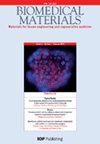Bioinspired TiO2/chitosan/HA coatings on Ti surfaces: biomedical improvement by intermediate hierarchical films
IF 3.7
3区 医学
Q2 ENGINEERING, BIOMEDICAL
引用次数: 8
Abstract
The most common reasons for hard-tissue implant failure are structural loosening and prosthetic infections. Hence, in this study, to overcome the first problem, different bioinspired coatings, including dual acid-etched, anodic TiO2 nanotubes array, anodic hierarchical titanium oxide (HO), micro- and nanostructured hydroxyapatite (HA) layers, and HA/chitosan (HA/CS) nanocomposite, were applied to the titanium alloy surfaces. X-ray diffraction and FTIR analysis demonstrated that the in situ HA/CS nanocomposite formed successfully. The MTT assay showed that all samples had excellent cell viability, with cell proliferation rates ranging from 120% to 150% after 10 days. The HO coating demonstrated superhydrophilicity (θ ≈ 0°) and increased the wettability of the metallic Ti surface by more than 120%. The friction coefficient of all fabricated surfaces was within the range of natural bone’s mechanical behavior. The intermediate HO layer increased the adhesion strength of the HA/CS coating by more than 60%. The HO layer caused the mechanical stability of HA/CS during the 1000 m of friction test. The microhardness of HA/CS (22.5 HV) and micro-HA (25.5 HV) coatings was comparable to that of human bone. A mechanism for improved adhesion strength of HA/CS coatings by intermediate oxide layer was proposed.钛表面的仿生TiO2/壳聚糖/透明质酸涂层:中间分层膜的生物医学改善
硬组织植入失败的最常见原因是结构松动和假体感染。因此,在本研究中,为了克服第一个问题,将不同的生物启发涂层应用于钛合金表面,包括双酸蚀刻的阳极TiO2纳米管阵列、阳极分级氧化钛(HO)、微结构和纳米结构羟基磷灰石(HA)层以及HA/壳聚糖(HA/CS)纳米复合材料。X射线衍射和FTIR分析表明,原位HA/CS纳米复合材料成功形成。MTT法显示,所有样品都具有良好的细胞活力,10天后细胞增殖率在120%至150%之间。HO涂层表现出超亲水性(θ≈0°),并使金属Ti表面的润湿性提高了120%以上。所有制造表面的摩擦系数都在自然骨骼力学行为的范围内。中间HO层使HA/CS涂层的粘合强度增加了60%以上。HO层在1000m的摩擦试验期间引起HA/CS的机械稳定性。HA/CS(22.5HV)和微HA(25.5HV)涂层的显微硬度与人骨的显微硬度相当。提出了中间氧化层提高HA/CS涂层结合强度的机理。
本文章由计算机程序翻译,如有差异,请以英文原文为准。
求助全文
约1分钟内获得全文
求助全文
来源期刊

Biomedical materials
工程技术-材料科学:生物材料
CiteScore
6.70
自引率
7.50%
发文量
294
审稿时长
3 months
期刊介绍:
The goal of the journal is to publish original research findings and critical reviews that contribute to our knowledge about the composition, properties, and performance of materials for all applications relevant to human healthcare.
Typical areas of interest include (but are not limited to):
-Synthesis/characterization of biomedical materials-
Nature-inspired synthesis/biomineralization of biomedical materials-
In vitro/in vivo performance of biomedical materials-
Biofabrication technologies/applications: 3D bioprinting, bioink development, bioassembly & biopatterning-
Microfluidic systems (including disease models): fabrication, testing & translational applications-
Tissue engineering/regenerative medicine-
Interaction of molecules/cells with materials-
Effects of biomaterials on stem cell behaviour-
Growth factors/genes/cells incorporated into biomedical materials-
Biophysical cues/biocompatibility pathways in biomedical materials performance-
Clinical applications of biomedical materials for cell therapies in disease (cancer etc)-
Nanomedicine, nanotoxicology and nanopathology-
Pharmacokinetic considerations in drug delivery systems-
Risks of contrast media in imaging systems-
Biosafety aspects of gene delivery agents-
Preclinical and clinical performance of implantable biomedical materials-
Translational and regulatory matters
 求助内容:
求助内容: 应助结果提醒方式:
应助结果提醒方式:


